ESP FIAT PANDA 2018 Owner handbook (in English)
[x] Cancel search | Manufacturer: FIAT, Model Year: 2018, Model line: PANDA, Model: FIAT PANDA 2018Pages: 228, PDF Size: 17.05 MB
Page 115 of 228
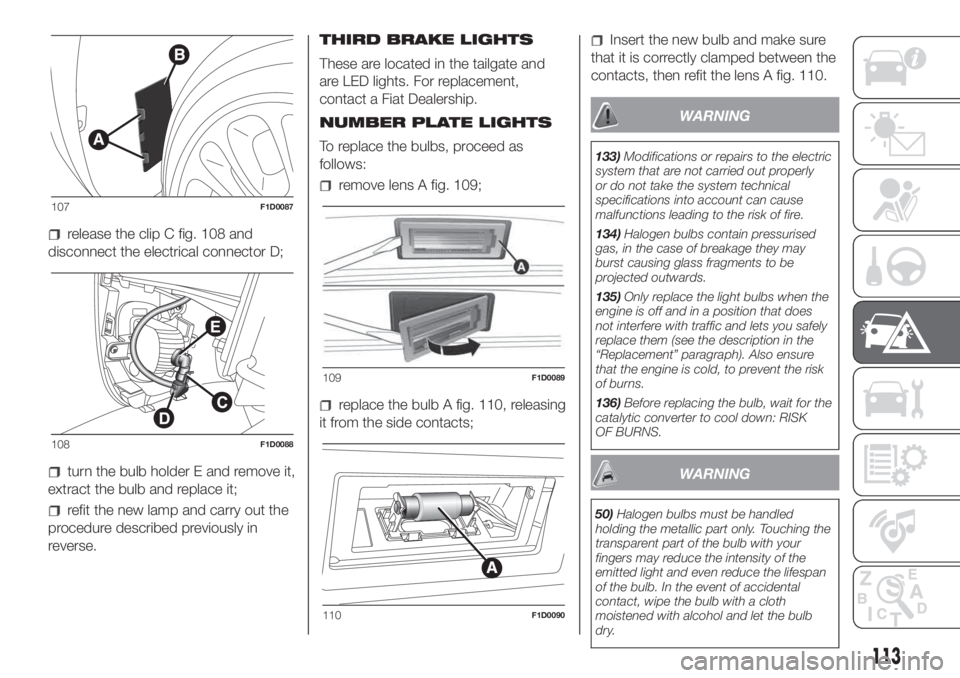
release the clip C fig. 108 and
disconnect the electrical connector D;
turn the bulb holder E and remove it,
extract the bulb and replace it;
refit the new lamp and carry out the
procedure described previously in
reverse.THIRD BRAKE LIGHTS
These are located in the tailgate and
are LED lights. For replacement,
contact a Fiat Dealership.
NUMBER PLATE LIGHTS
To replace the bulbs, proceed as
follows:
remove lens A fig. 109;
replace the bulb A fig. 110, releasing
it from the side contacts;
Insert the new bulb and make sure
that it is correctly clamped between the
contacts, then refit the lens A fig. 110.
WARNING
133)Modifications or repairs to the electric
system that are not carried out properly
or do not take the system technical
specifications into account can cause
malfunctions leading to the risk of fire.
134)Halogen bulbs contain pressurised
gas, in the case of breakage they may
burst causing glass fragments to be
projected outwards.
135)Only replace the light bulbs when the
engine is off and in a position that does
not interfere with traffic and lets you safely
replace them (see the description in the
“Replacement” paragraph). Also ensure
that the engine is cold, to prevent the risk
of burns.
136)Before replacing the bulb, wait for the
catalytic converter to cool down: RISK
OF BURNS.
WARNING
50)Halogen bulbs must be handled
holding the metallic part only. Touching the
transparent part of the bulb with your
fingers may reduce the intensity of the
emitted light and even reduce the lifespan
of the bulb. In the event of accidental
contact, wipe the bulb with a cloth
moistened with alcohol and let the bulb
dry.
107F1D0087
108F1D0088
109F1D0089
110F1D0090
113
Page 116 of 228
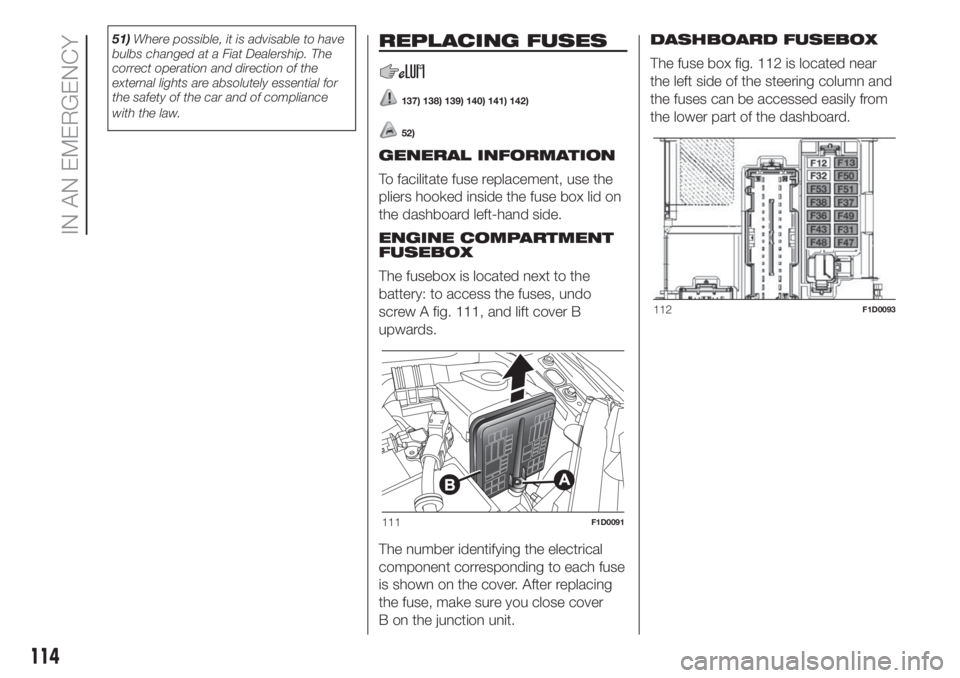
51)Where possible, it is advisable to have
bulbs changed at a Fiat Dealership. The
correct operation and direction of the
external lights are absolutely essential for
the safety of the car and of compliance
with the law.REPLACING FUSES
137) 138) 139) 140) 141) 142)
52)
GENERAL INFORMATION
To facilitate fuse replacement, use the
pliers hooked inside the fuse box lid on
the dashboard left-hand side.
ENGINE COMPARTMENT
FUSEBOX
The fusebox is located next to the
battery: to access the fuses, undo
screw A fig. 111, and lift cover B
upwards.
The number identifying the electrical
component corresponding to each fuse
is shown on the cover. After replacing
the fuse, make sure you close cover
B on the junction unit.DASHBOARD FUSEBOX
The fuse box fig. 112 is located near
the left side of the steering column and
the fuses can be accessed easily from
the lower part of the dashboard.
111F1D0091
112F1D0093
114
IN AN EMERGENCY
Page 121 of 228
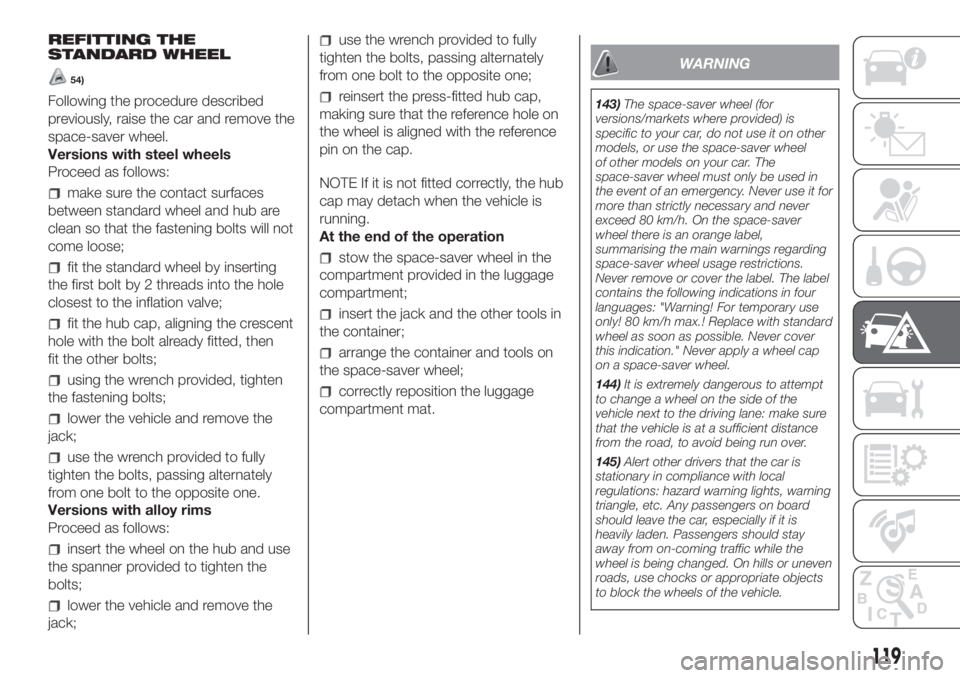
REFITTING THE
STANDARD WHEEL
54)
Following the procedure described
previously, raise the car and remove the
space-saver wheel.
Versions with steel wheels
Proceed as follows:
make sure the contact surfaces
between standard wheel and hub are
clean so that the fastening bolts will not
come loose;
fit the standard wheel by inserting
the first bolt by 2 threads into the hole
closest to the inflation valve;
fit the hub cap, aligning the crescent
hole with the bolt already fitted, then
fit the other bolts;
using the wrench provided, tighten
the fastening bolts;
lower the vehicle and remove the
jack;
use the wrench provided to fully
tighten the bolts, passing alternately
from one bolt to the opposite one.
Versions with alloy rims
Proceed as follows:
insert the wheel on the hub and use
the spanner provided to tighten the
bolts;
lower the vehicle and remove the
jack;
use the wrench provided to fully
tighten the bolts, passing alternately
from one bolt to the opposite one;
reinsert the press-fitted hub cap,
making sure that the reference hole on
the wheel is aligned with the reference
pin on the cap.
NOTE If it is not fitted correctly, the hub
cap may detach when the vehicle is
running.
At the end of the operation
stow the space-saver wheel in the
compartment provided in the luggage
compartment;
insert the jack and the other tools in
the container;
arrange the container and tools on
the space-saver wheel;
correctly reposition the luggage
compartment mat.
WARNING
143)The space-saver wheel (for
versions/markets where provided) is
specific to your car, do not use it on other
models, or use the space-saver wheel
of other models on your car. The
space-saver wheel must only be used in
the event of an emergency. Never use it for
more than strictly necessary and never
exceed 80 km/h. On the space-saver
wheel there is an orange label,
summarising the main warnings regarding
space-saver wheel usage restrictions.
Never remove or cover the label. The label
contains the following indications in four
languages: "Warning! For temporary use
only! 80 km/h max.! Replace with standard
wheel as soon as possible. Never cover
this indication." Never apply a wheel cap
on a space-saver wheel.
144)It is extremely dangerous to attempt
to change a wheel on the side of the
vehicle next to the driving lane: make sure
that the vehicle is at a sufficient distance
from the road, to avoid being run over.
145)Alert other drivers that the car is
stationary in compliance with local
regulations: hazard warning lights, warning
triangle, etc. Any passengers on board
should leave the car, especially if it is
heavily laden. Passengers should stay
away from on-coming traffic while the
wheel is being changed. On hills or uneven
roads, use chocks or appropriate objects
to block the wheels of the vehicle.
119
Page 130 of 228

SCHEDULED
SERVICING
Correct servicing is crucial for
guaranteeing a long life for the car
under the best conditions.
For this reason, Fiat has planned a
series of checks and services at fixed
distance and/or time intervals, as
described in the Service Schedule.
To keep the car’s efficiency in tip-top
condition, in the previous Scheduled
Service plan pages a few additional
checks are listed that should be carried
out more frequently with respect to
the normal coupon redemption
schedule.
Scheduled Servicing is offered by all
Fiat Dealerships according to a set time
schedule. If, during each operation, in
addition to the ones scheduled, the
need arises for further replacements or
repairs, these may be carried out with
the owner's explicit agreement only.
If your car is used frequently for towing,
the interval between one scheduled
servicing operation and the next should
be reduced.IMPORTANT Scheduled Servicing
interventions are set out by the
Manufacturer. Failure to have them
carried out may invalidate the warranty.
It is advisable to inform a Fiat
Dealership of any small operating
irregularities without waiting for the next
service.
PERIODIC CHECKS
Every1,000km or before long
journeys, check and if necessary, top
up: engine coolant level; brake fluid
level; screen washer fluid level; tyre
inflation pressure and condition; lighting
system operation (headlights, direction
indicators, hazard warning lights, etc.);
screen washer/wiper system operation
and positioning/wear of windscreen/
rear window wiper blades.
Every3,000km, check and top up if
required: engine oil level.
For cars with 0.9 TwinAir engines:
every3,000km check the engine oil
level and top it up to the maximum level
if necessary.DEMANDING USE OF THE
CAR
If the car is used under one of the
following conditions: towing a trailer or
motorhome; dusty roads; short (less
than 7-8 km) and repeated journeys
with sub-zero outside temperatures;
engine often idling or driving long
distances at low speed or long periods
of inactivity, the following checks must
be carried out more often than
indicated in the Scheduled Servicing
Plan:
check front disc brake pad condition
and wear;
check the cleanliness of the side,
bonnet and luggage compartment
locks, and the cleanliness and
lubrication of the linkages;
visually inspect conditions of:
engine, gearbox, transmission, pipes
and hoses (exhaust/fuel system/brakes)
and rubber elements (gaiters/sleeves/
bushes, etc.);
check battery charge and battery
fluid level (electrolyte);
visually inspect conditions of the
accessory drive belts;
check and, if necessary, change
engine oil and replace oil filter / pollen
filter / air cleaner.
128
SERVICING AND CARE
Page 135 of 228
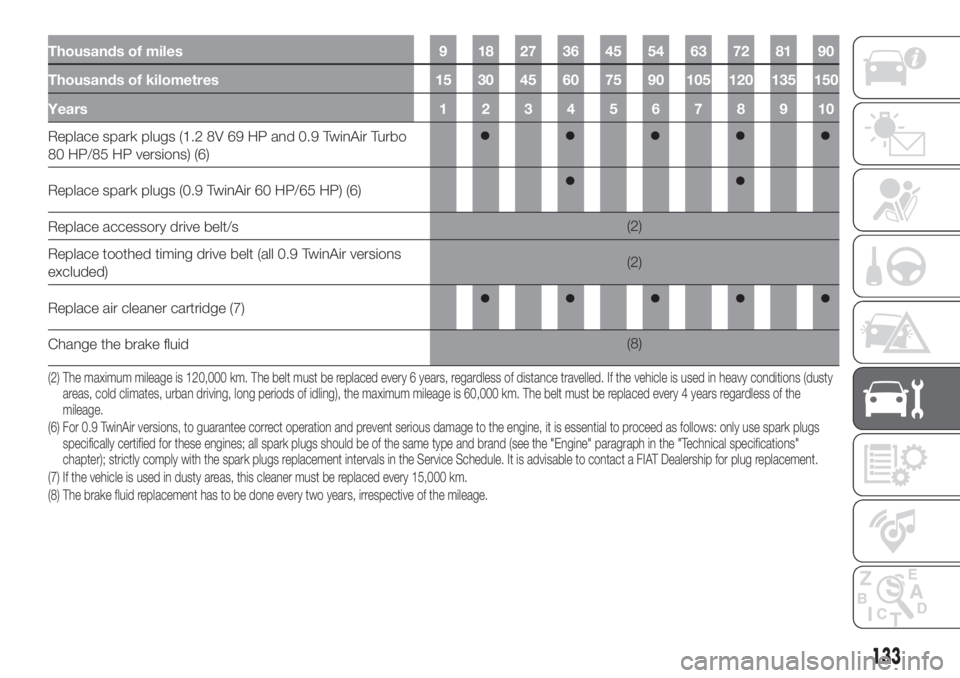
Thousands of miles 9 18 27 36 45 54 63 72 81 90
Thousands of kilometres 15 30 45 60 75 90 105 120 135 150
Years12345678910
Replace spark plugs (1.2 8V 69 HP and 0.9 TwinAir Turbo
80 HP/85 HP versions) (6)
Replace spark plugs (0.9 TwinAir 60 HP/65 HP) (6)
Replace accessory drive belt/s(2)
Replace toothed timing drive belt (all 0.9 TwinAir versions
excluded)(2)
Replace air cleaner cartridge (7)
Change the brake fluid(8)
(6) For 0.9 TwinAir versions, to guarantee correct operation and prevent serious damage to the engine, it is essential to proceed as follows: only use spark plugs
specifically certified for these engines; all spark plugs should be of the same type and brand (see the "Engine" paragraph in the "Technical specifications"
chapter); strictly comply with the spark plugs replacement intervals in the Service Schedule. It is advisable to contact a FIAT Dealership for plug replacement. (2) The maximum mileage is 120,000 km. The belt must be replaced every 6 years, regardless of distance travelled. If the vehicle is used in heavy conditions (dusty
areas, cold climates, urban driving, long periods of idling), the maximum mileage is 60,000 km. The belt must be replaced every 4 years regardless of the
mileage.
(7) If the vehicle is used in dusty areas, this cleaner must be replaced every 15,000 km.
(8) The brake fluid replacement has to be done every two years, irrespective of the mileage.
133
Page 140 of 228
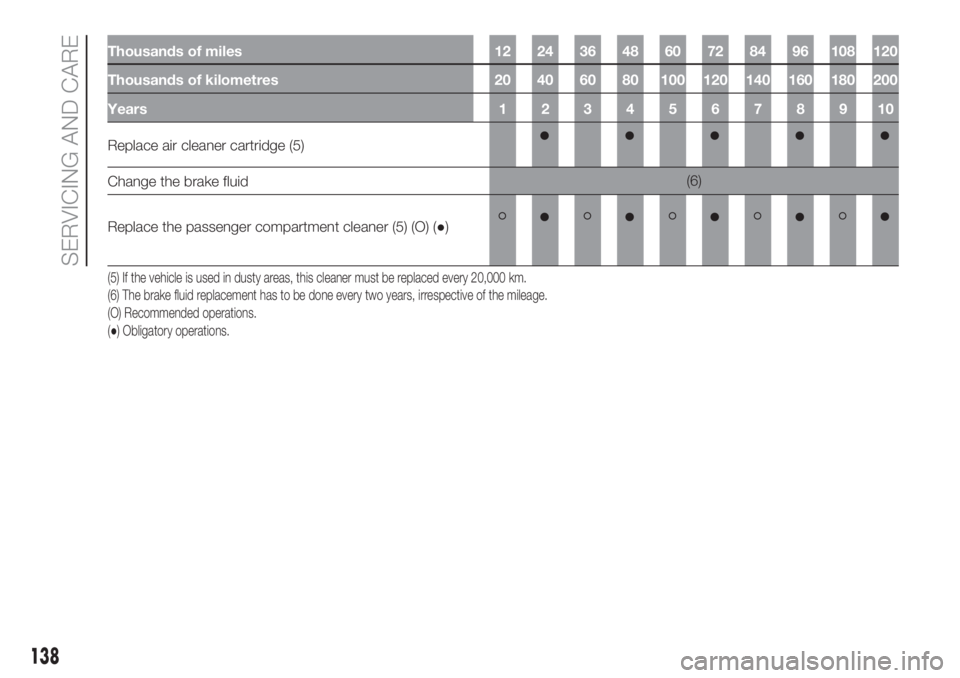
Thousands of miles 12 24 36 48 60 72 84 96 108 120
Thousands of kilometres 20 40 60 80 100 120 140 160 180 200
Years12345678910
Replace air cleaner cartridge (5)
Change the brake fluid(6)
Replace the passenger compartment cleaner (5) (O) (●)
(5) If the vehicle is used in dusty areas, this cleaner must be replaced every 20,000 km.
(6) The brake fluid replacement has to be done every two years, irrespective of the mileage.
(O) Recommended operations.
(●) Obligatory operations.
138
SERVICING AND CARE
Page 148 of 228
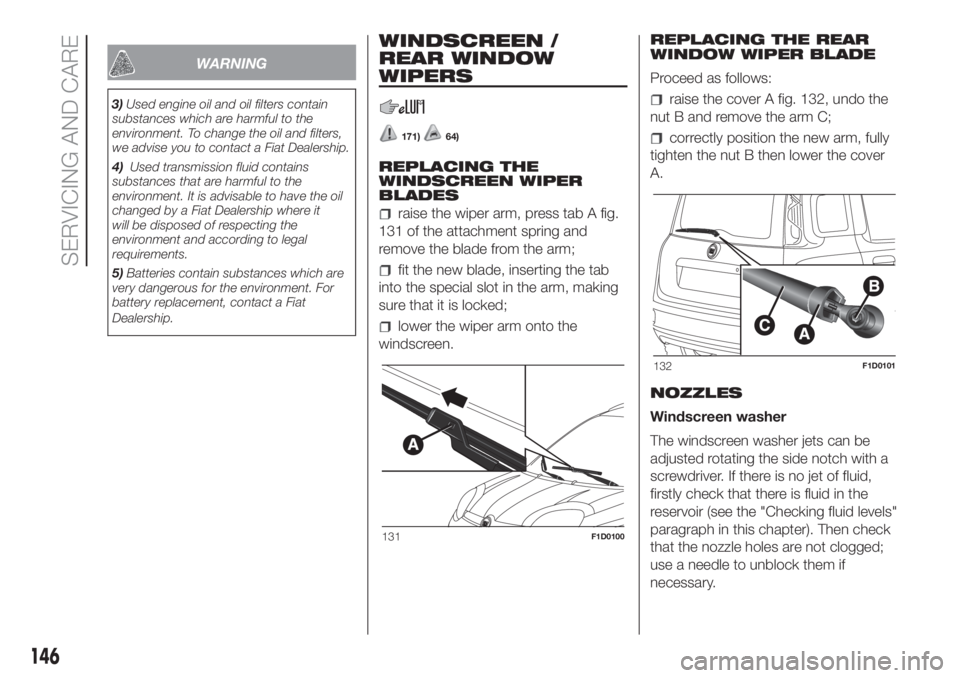
WARNING
3)Used engine oil and oil filters contain
substances which are harmful to the
environment. To change the oil and filters,
we advise you to contact a Fiat Dealership.
4)Used transmission fluid contains
substances that are harmful to the
environment. It is advisable to have the oil
changed by a Fiat Dealership where it
will be disposed of respecting the
environment and according to legal
requirements.
5)Batteries contain substances which are
very dangerous for the environment. For
battery replacement, contact a Fiat
Dealership.
WINDSCREEN /
REAR WINDOW
WIPERS
171)64)
REPLACING THE
WINDSCREEN WIPER
BLADES
raise the wiper arm, press tab A fig.
131 of the attachment spring and
remove the blade from the arm;
fit the new blade, inserting the tab
into the special slot in the arm, making
sure that it is locked;
lower the wiper arm onto the
windscreen.REPLACING THE REAR
WINDOW WIPER BLADE
Proceed as follows:
raise the cover A fig. 132, undo the
nut B and remove the arm C;
correctly position the new arm, fully
tighten the nut B then lower the cover
A.
NOZZLES
Windscreen washer
The windscreen washer jets can be
adjusted rotating the side notch with a
screwdriver. If there is no jet of fluid,
firstly check that there is fluid in the
reservoir (see the "Checking fluid levels"
paragraph in this chapter). Then check
that the nozzle holes are not clogged;
use a needle to unblock them if
necessary.
131F1D0100
132F1D0101
146
SERVICING AND CARE
Page 153 of 228
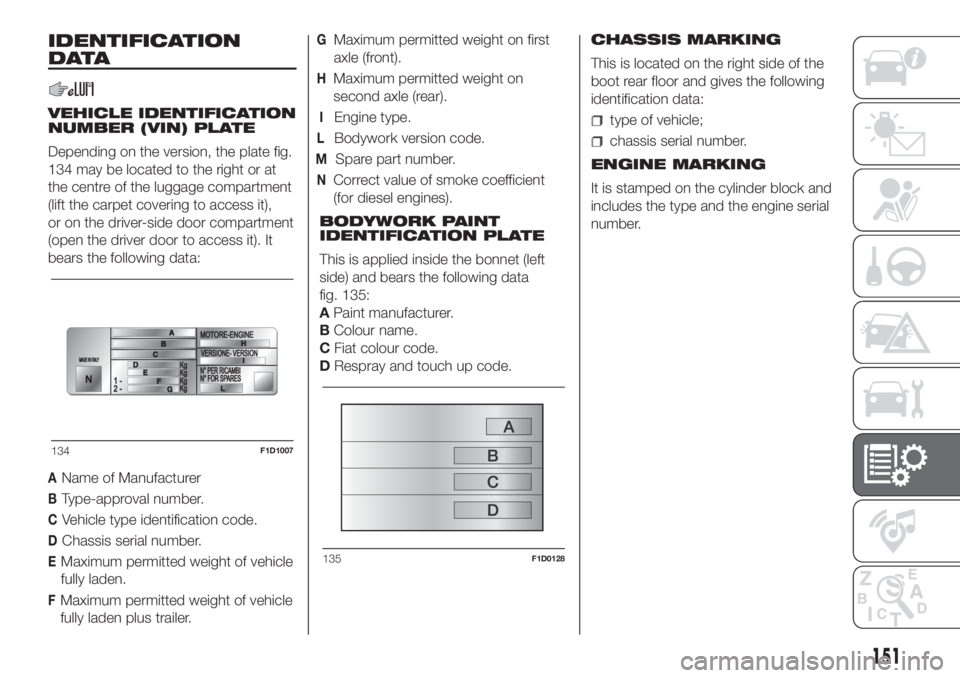
IDENTIFICATION
DATA
VEHICLE IDENTIFICATION
NUMBER (VIN) PLATE
Depending on the version, the plate fig.
134 may be located to the right or at
the centre of the luggage compartment
(lift the carpet covering to access it),
or on the driver-side door compartment
(open the driver door to access it). It
bears the following data:
AName of Manufacturer
BType-approval number.
CVehicle type identification code.
DChassis serial number.
EMaximum permitted weight of vehicle
fully laden.
FMaximum permitted weight of vehicle
fully laden plus trailer.
GMaximum permitted weight on first
axle (front).
HMaximum permitted weight on
second axle (rear).
IEngine type.
LBodywork version code.
MSpare part number.
NCorrect value of smoke coefficient
(for diesel engines).
BODYWORK PAINT
IDENTIFICATION PLATE
This is applied inside the bonnet (left
side) and bears the following data
fig. 135:
APaint manufacturer.
BColour name.
CFiat colour code.
DRespray and touch up code.CHASSIS MARKING
This is located on the right side of the
boot rear floor and gives the following
identification data:
type of vehicle;
chassis serial number.
ENGINE MARKING
It is stamped on the cylinder block and
includes the type and the engine serial
number.
134F1D1007
135F1D0128
151
Page 154 of 228
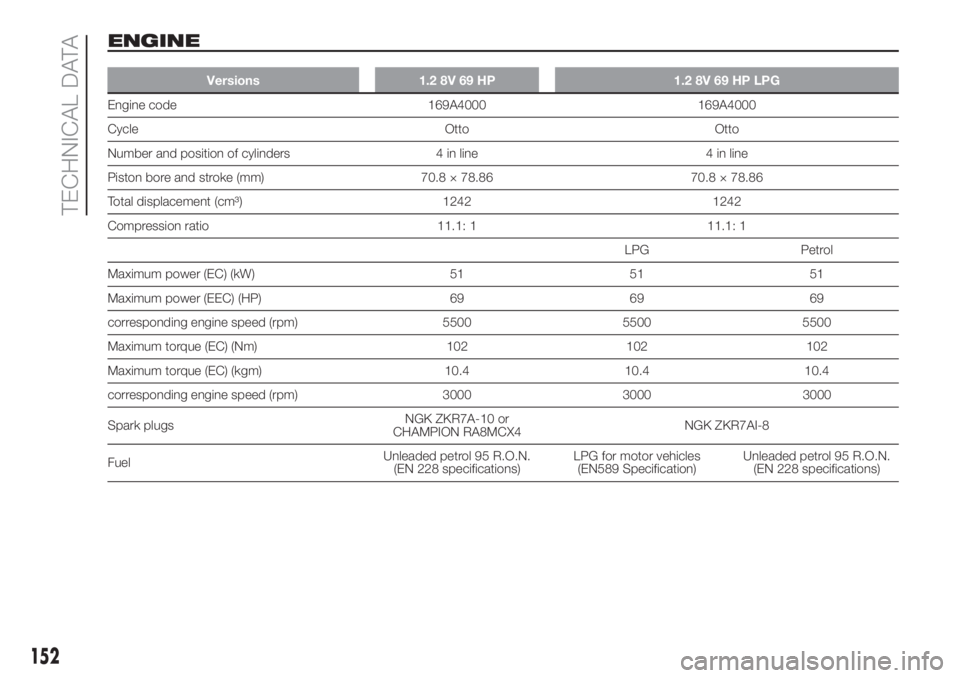
ENGINE
Versions 1.2 8V 69 HP 1.2 8V 69 HP LPG
Engine code 169A4000 169A4000
Cycle Otto Otto
Number and position of cylinders 4 in line 4 in line
Piston bore and stroke (mm) 70.8 × 78.86 70.8 × 78.86
Total displacement (cm³) 1242 1242
Compression ratio 11.1: 1 11.1: 1
LPG Petrol
Maximum power (EC) (kW) 51 51 51
Maximum power (EEC) (HP) 69 69 69
corresponding engine speed (rpm) 5500 5500 5500
Maximum torque (EC) (Nm) 102 102 102
Maximum torque (EC) (kgm) 10.4 10.4 10.4
corresponding engine speed (rpm) 3000 3000 3000
Spark plugsNGK ZKR7A-10 or
CHAMPION RA8MCX4NGK ZKR7AI-8
FuelUnleaded petrol 95 R.O.N.
(EN 228 specifications)LPG for motor vehicles
(EN589 Specification)Unleaded petrol 95 R.O.N.
(EN 228 specifications)
152
TECHNICAL DATA
Page 155 of 228
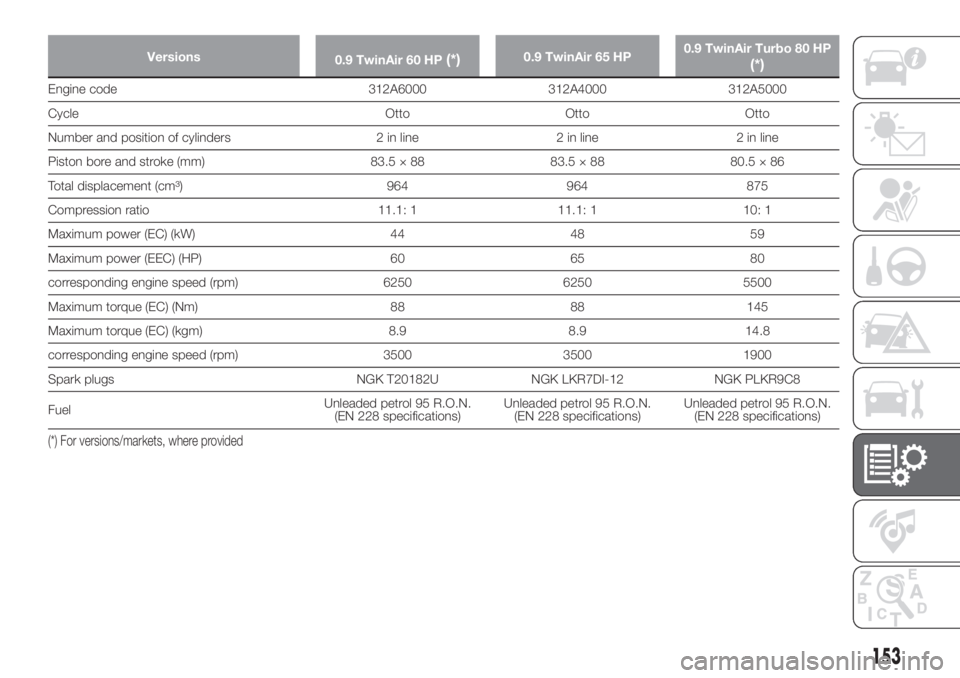
Versions
0.9 TwinAir 60 HP(*)0.9 TwinAir 65 HP0.9 TwinAir Turbo 80 HP(*)
Engine code 312A6000 312A4000 312A5000
Cycle Otto Otto Otto
Number and position of cylinders 2 in line 2 in line 2 in line
Piston bore and stroke (mm) 83.5 × 88 83.5 × 88 80.5 × 86
Total displacement (cm³) 964 964 875
Compression ratio 11.1: 1 11.1: 1 10: 1
Maximum power (EC) (kW) 44 48 59
Maximum power (EEC) (HP) 60 65 80
corresponding engine speed (rpm) 6250 6250 5500
Maximum torque (EC) (Nm) 88 88 145
Maximum torque (EC) (kgm) 8.9 8.9 14.8
corresponding engine speed (rpm) 3500 3500 1900
Spark plugs NGK T20182U NGK LKR7DI-12 NGK PLKR9C8
FuelUnleaded petrol 95 R.O.N.
(EN 228 specifications)Unleaded petrol 95 R.O.N.
(EN 228 specifications)Unleaded petrol 95 R.O.N.
(EN 228 specifications)
(*) For versions/markets, where provided
153